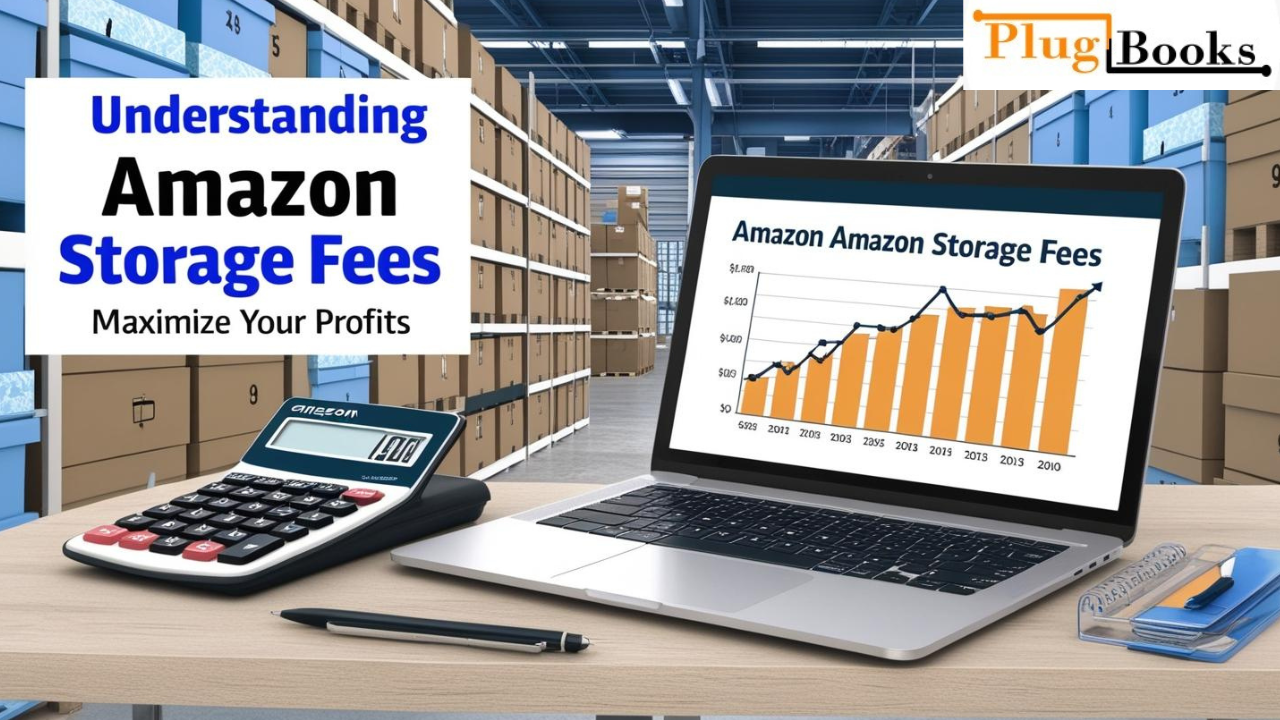If you sell products on Amazon, you have most likely paid Amazon storage costs. Your profitability may be greatly affected by these fees, particularly if you are not entirely clear about their workings. Charges Amazon makes for keeping your goods in its fulfillment facilities are known as storage costs. Maximizing your expenses and making sure your company remains successful depend on your knowledge of these expenses.
We will guide you through what you need to know about Amazon storage fees in this post: how to compute Amazon storage fees using the Amazon storage charge calculator, what variables affect Amazon storage rates, and how to cut Amazon storage costs to save money.
Keynotes
- Product size, weight, and season of year affect Amazon storage costs.
- Track and control storage expenditures with the Amazon Storage Fee Calculator.
- By improving your inventory control methods, you can reduce storage costs.
- Know the long-term costs for slow-moving inventory storage.
- Plugbooks.io provides tools to enable efficient computation of Amazon storage costs and management of them.
What are Amazon Storage Fees?
Amazon storage fees are those expenses Amazon pays to keep your goods in its warehouses. As part of the Fulfillment by Amazon (FBA) service, these costs are computed using your product’s weight and dimensions. Paying these costs falls on you as an Amazon seller; they vary based on the product type, time of year, and inventory level.
Monthly Amazon storage costs are applied by Amazon, varying for standard-size and big products. If you’re not diligent about inventory control, these costs may up rapidly.
Calculating Amazon Storage Fees: Methodology
1. Amazon Rates of Storage
Two significant divisions exist in Amazon storage rates:
- Monthly storage fees: These are paid depending on the space your goods occupy in Amazon’s fulfillment hubs. The time of year affects rates; greater fees usually apply during busy seasons like Q4 (the Christmas season).
- Should your merchandise remain in Amazon’s warehouse for more than 365 days, Amazon imposes long-term storage costs—much greater than monthly storage rates.
- Examining both monthly and long-term storage costs can help you to have a correct awareness of your Amazon storage cost.
2. How Would One Use the Amazon Storage Fee Calculator?
The Amazon storage cost calculator is a simple approach to monitor your charges. This tool lets you figure out your precise storage expenses depending on the weight and dimensions of your merchandise. Entering the weight and dimensions of your goods will let the calculator estimate your monthly storage cost, therefore helping you to better understand your whole storage expenses.
Regular use of the Amazon storage fees calculator can help you to better control your inventory and save avoidable storage costs.
Elements Affecting Amazon Storage Costs
1. Product weight and size
The cost of Amazon storage is significantly influenced by the weight and size of your products. Bigger and heavier objects occupy more room in Amazon’s warehouses, which drives up storage costs. Those classified as “oversized” will have higher Amazon storage rates than those classified as standard-sized.
2. Season of Year
Amazon changes their storage cost according to the season. Usually, demand for warehouse space drives higher fees during the holiday season—October through December. Should you be keeping items during these months, your Amazon storage costs will be higher.
3. Turnover of Inventory
Your Amazon storage charges will be less the sooner your goods sell. Particularly if it falls under long-term storage charges, slow-moving material kept in Amazon’s warehouses for a length of time would incur extra costs.

Strategies for Reducing Your Amazon Storage Charges
1. Improve supply control.
Reducing Amazon storage charges mostly depends on smart inventory management. Try to maintain balanced stock levels and make sure you are not overstocking slow-selling items. You may make sure you’re not paying for unneeded space by analyzing your sales data and approximating expenses using the Amazon storage fees calculator.
2. Apply Amazon’s FBA Fee Discounts.
For items qualified for its FBA program, Amazon provides reductions on storage costs. Your items must satisfy certain criteria, including a strong sell-through rate and participation in a seasonal campaign, to qualify.
3. Routinely check your inventory.
Review your inventory often and eliminate any slow-moving products that could be lingering in Amazon’s warehouses for far too long. By keeping your product fresh and moving, you may avoid long-term storage costs and ensure that you’re only paying for the Amazon storage expenses connected with fast-moving items.

Amazon Storage Fees and Plugbooks: Your Ally in Inventory Management
Keeping track of your Amazon storage fees is vital for any Amazon seller to prevent unwarranted expenses. We at Plugbooks.io provide strong tools and services to let vendors just like you effectively handle their inventory and money. Our system lets you easily calculate your storage prices and grasp Amazon storage rates so you can concentrate on expanding your company, free from concern about hidden expenses.
Conclusion
Any Amazon vendor must first grasp Amazon storage costs. Knowing how to figure your storage expenses and using the Amazon storage charge calculator can help you maximize your inventory and save unneeded expenditures. To keep the cost of Amazon storage low and maximize revenue, pay attention to Amazon storage rates, product size, and turnover pace.
Maintaining control of these expenses will help to guarantee that hidden expenses have no detrimental effect on your bottom line if you are committed to operating a profitable Amazon company.
Disclaimer:
This page is solely for informative needs. Your inventory and Amazon’s regulations will influence the particular Amazon storage cost computations. For the most accurate computations, always utilize Amazon’s official tools and resources.





2 thoughts on “Understanding Amazon Storage Fees: What You Need to Know”